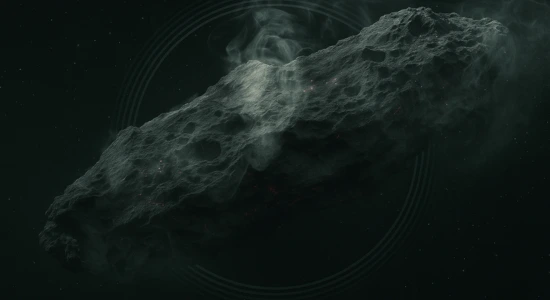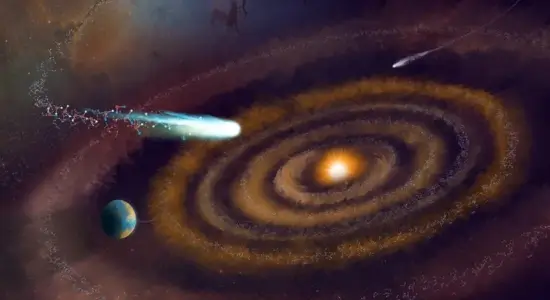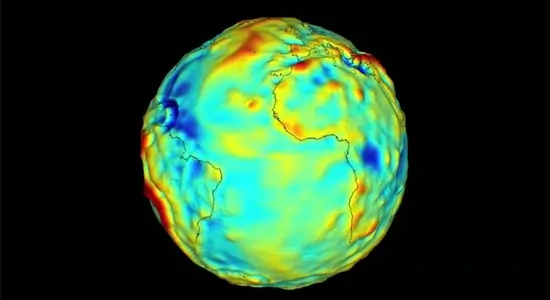WE JINXED IT: THE GOLDEN COMET C/2025 K1 (ATLAS) HAS SPLIT INTO PIECES
Remember that weirdly luminous, gorgeous chunk of ice and rock called Comet C/2025 K1 (ATLAS)? The one that was so close to the Sun that everyone bet against its survival, but then it actually made it out, glowing an impossible gold? Yeah, well, we totally jinxed it.
Our tiny golden survivor from the farthest reaches of the Solar System decided to celebrate its close encounter with our star by promptly breaking apart a few weeks later. Because space, apparently, has a very dark sense of humor.
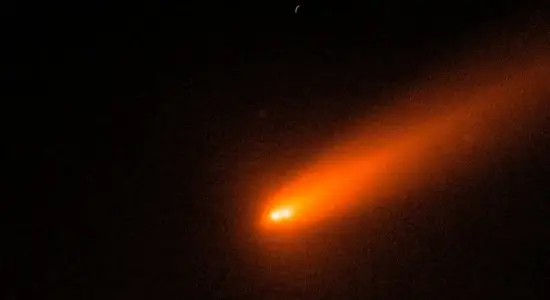 The comet captured during its fragmentation on the night of November 11–12. Image Credit: F. Ferrigno/Inaf/Univ. Parthenope
The comet captured during its fragmentation on the night of November 11–12. Image Credit: F. Ferrigno/Inaf/Univ. Parthenope
The Great Comet Breakup: When Survival Just Isn’t Enough
Comet C/2025 K1 (ATLAS) was a true celebrity among the 2025 comets. Not only did it swing closer to the Sun than Mercury—a feat that usually vaporizes or disintegrates weaker comets—it also managed to survive its terrifying perihelion pass on October 8.
For a brief, shining moment, it seemed like this icy visitor, believed to have traveled from the distant, pristine Oort Cloud, was structurally sound. But it turns out, the Sun is like that one friend who looks friendly, but their intensity eventually wears you down.
Astronomers, using powerful telescopes like the 1.82m Copernicus telescope at the Asiago Observatory in Italy, confirmed the inevitable beginning around November 11–12. The comet’s nucleus, weakened by the solar heat and the explosive outgassing, finally gave up the ghost. It had fragmented into at least two major, roughly equal pieces—dubbed Fragment A and Fragment B—plus a smaller, fainter third piece in tow.
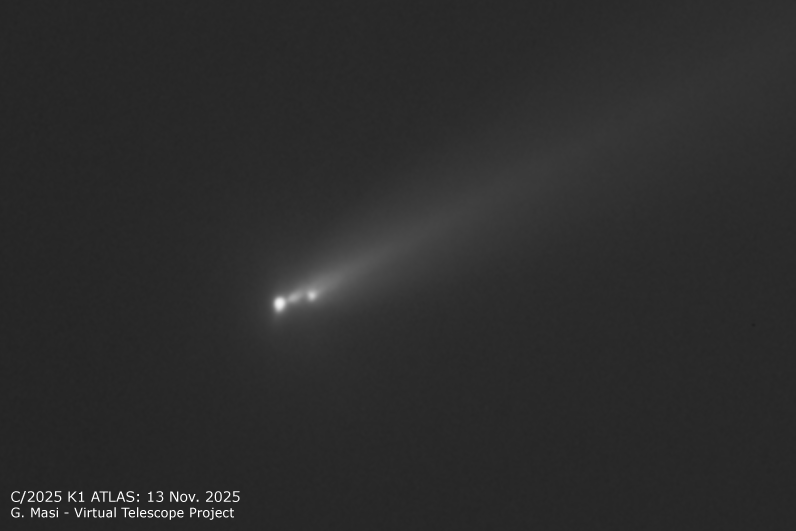 The changing appearance of Comet C/2025 K1 (ATLAS) between November 12 and 13, 2025. Image Credit: Ginaluca Masi/Virtual Telescope Project
The changing appearance of Comet C/2025 K1 (ATLAS) between November 12 and 13, 2025. Image Credit: Ginaluca Masi/Virtual Telescope Project
Images from that night show the fragments slowly separating, which is simultaneously beautiful and heartbreaking. It’s the universe’s way of saying: “Yeah, you made it past the boss level, but did you remember the structural integrity check?”
The Golden Mystery: Why This Comet Was Special
The fragmentation of a comet is a huge scientific bonus, especially when the comet is “new”—meaning it’s on its first trip into the inner Solar System, carrying pristine, ancient material.
But ATLAS wasn’t just old; it was chemically bizarre.
While most comets appear blue-green due to the emission of diatomic carbon (C₂), C/2025 K1 had a strikingly low amount of these carbon-chain molecules. This strange chemistry led to its peculiar golden glow, created by sunlight reflecting off its unique dust composition.
Scientists believe this lack of common carbon-containing compounds, coupled with its Oort Cloud origin, is precisely what made its nucleus so fragile. When the Sun’s heat caused the internal ice to sublimate (turn directly to gas) too rapidly, the internal pressure was too much, causing the whole thing to crack like a cosmic egg.
What Happens to the Pieces Now?
For those of you who still want to witness the remnants of this magnificent failure, you’re in luck—sort of.
The debris cloud, which now includes the separated main fragments, will make its closest approach to Earth around November 24–25, passing at a relatively safe distance of about 60 million kilometers (37.3 million miles).
 The golden comet as captured earlier this month. Image courtesy of Dan Bartlett
The golden comet as captured earlier this month. Image courtesy of Dan Bartlett
Unfortunately, the breakup means the comet won’t brighten enough to become visible to the naked eye. It’s currently hovering around magnitude 9.5–9.9, which means you’ll need at least a pair of decent binoculars or a mid-range telescope to catch the ghostly image of its scattered remains, currently moving through the constellation Leo.
So, pour one out for the Golden Comet. It survived the Sun, only to be killed by physics.
🧠 Did You Know?
The cosmos is full of bizarre events, often involving gravity and newly discovered worlds—just like our poor, shattered Golden Comet!
-
Earth’s Gravity Crisis: While ATLAS was battling the Sun’s forces, NASA detected a massive, 7,000-kilometer-wide gravity anomaly—a mysterious “dip” in the gravitational field—over the Atlantic Ocean. This gravity well, known as the South Atlantic Anomaly, is causing headaches for satellites, but it offers a fascinating glimpse into the unusual magnetic forces surrounding our own planet. Want to know more about this powerful dip? Read about the NASA Detects 7,000-Kilometer Gravity Anomaly Over the Atlantic.
-
A Baby Planet’s Debut: On the other side of the universe, the James Webb Space Telescope (JWST) just scored its first exoplanet discovery: a gas giant the size of Saturn, nicknamed “MASCARA-4b.” Finding a planet this young and still forming is rare, and it’s already giving scientists crucial clues about how worlds assemble themselves in chaotic cosmic nurseries. Learn more about this exciting first find and its implications for planetary science in the full article: JWST Discovers Its First Exoplanet—A Saturn-Sized Infant.
ref : IFLScience , Space


